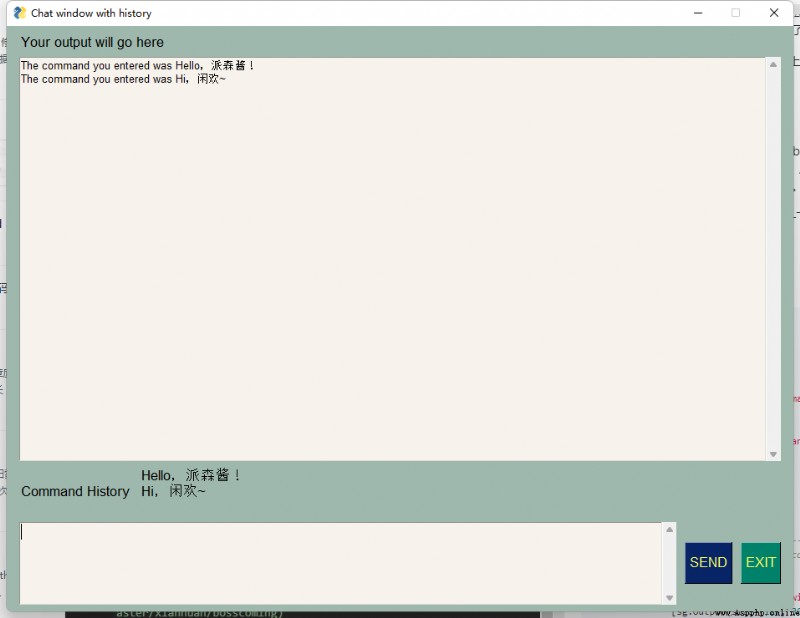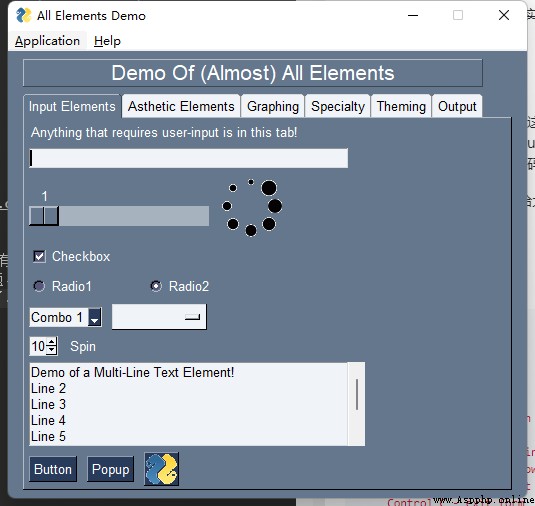今天給大家介紹一款 python 的 GUI 神器 —— PySimpleGUI,這個庫確實比較簡單,除了界面稍微有點“原始”,其他都沒毛病。
其實像 PySimpleGUI 這類 GUI 界面,跟 Web 頁面是不具備可比性的,後者想做得美觀簡直太容易了。而 GUI 界面本來就是為了生成可執行的軟件而生的,在美觀上先天性不足。
PySimpleGUI 是 python GUI 框架中的佼佼者,適用於快速生成簡潔大方的 GUI。使用它來寫 GUI 已經比較快了,那麼還有沒有更快的方法嗎?
答案是肯定的,本文就為你揭曉!
PySimpleGUI 在GitHub上的地址是:
https://github.com/PySimpleGUI/PySimpleGUI
大家可以訪問看看,其首頁是這樣的:

有很多內容是不是?
這裡面有一個重要的內容,在 DemoPrograms 文件夾下,這個文件夾是作者寫的一些 demo 實例。作者真的是深谙我們這些懶蟲的心理,即使有了這麼簡單好用的 GUI 框架,到了要寫實例的時候,我們也可能會去網絡上搜索實例,然後采用 CV大法。框架作者可能料想到這一點,所以他自己寫了很多不同的實例,讓你真正的拿來即用。
這個文件夾下大概有300多個實例,基本上可以囊括我們平時使用 python 寫 GUI 所能遇到的各種組件和布局了。
有了這個神器,我們只需要把這個 GitHub 上的項目給復制到本地,然後將這些實例運行一遍,大致知道每個實例u哪些內容。後續當我們自己要寫 GUI 時,我們只需要找到對應的實例,然後復制代碼就可以了。是不是很簡單?
下面我來運行幾個 demo ,給大家展示一下這裡面的實例都是什麼樣子的。
我們先復制一下源碼:
#!/usr/bin/env python
import PySimpleGUI as sg
''' A chatbot with history Scroll up and down through prior commands using the arrow keys Special keyboard keys: Up arrow - scroll up in commands Down arrow - scroll down in commands Escape - clear current command Control C - exit form '''
def ChatBotWithHistory():
# ------- Make a new Window ------- #
# give our form a spiffy set of colors
sg.theme('GreenTan')
layout = [[sg.Text('Your output will go here', size=(40, 1))],
[sg.Output(size=(127, 30), font=('Helvetica 10'))],
[sg.Text('Command History'),
sg.Text('', size=(20, 3), key='history')],
[sg.ML(size=(85, 5), enter_submits=True, key='query', do_not_clear=False),
sg.Button('SEND', button_color=(sg.YELLOWS[0], sg.BLUES[0]), bind_return_key=True),
sg.Button('EXIT', button_color=(sg.YELLOWS[0], sg.GREENS[0]))]]
window = sg.Window('Chat window with history', layout,
default_element_size=(30, 2),
font=('Helvetica', ' 13'),
default_button_element_size=(8, 2),
return_keyboard_events=True)
# ---===--- Loop taking in user input and using it --- #
command_history = []
history_offset = 0
while True:
event, value = window.read()
if event == 'SEND':
query = value['query'].rstrip()
# EXECUTE YOUR COMMAND HERE
print('The command you entered was {}'.format(query))
command_history.append(query)
history_offset = len(command_history)-1
# manually clear input because keyboard events blocks clear
window['query'].update('')
window['history'].update('\n'.join(command_history[-3:]))
elif event in (sg.WIN_CLOSED, 'EXIT'): # quit if exit event or X
break
elif 'Up' in event and len(command_history):
command = command_history[history_offset]
# decrement is not zero
history_offset -= 1 * (history_offset > 0)
window['query'].update(command)
elif 'Down' in event and len(command_history):
# increment up to end of list
history_offset += 1 * (history_offset < len(command_history)-1)
command = command_history[history_offset]
window['query'].update(command)
elif 'Escape' in event:
window['query'].update('')
ChatBotWithHistory()
運行一下,看看效果:
這是一個帶歷史記錄的聊天軟件,如果你需要做一個類似的軟件的話,可以直接復制代碼,然後稍微改動一下。
我們再來看一個例子:
#!/usr/bin/env python
""" Example of (almost) all Elements, that you can use in PySimpleGUI. Shows you the basics including: Naming convention for keys Menubar format Right click menu format Table format Running an async event loop Theming your application (requires a window restart) Displays the values dictionary entry for each element And more! Copyright 2021 PySimpleGUI """
import PySimpleGUI as sg
def make_window(theme):
sg.theme(theme)
menu_def = [['&Application', ['E&xit']],
['&Help', ['&About']] ]
right_click_menu_def = [[], ['Nothing','More Nothing','Exit']]
# Table Data
data = [["John", 10], ["Jen", 5]]
headings = ["Name", "Score"]
input_layout = [[sg.Menu(menu_def, key='-MENU-')],
[sg.Text('Anything that requires user-input is in this tab!')],
[sg.Input(key='-INPUT-')],
[sg.Slider(orientation='h', key='-SKIDER-'),
sg.Image(data=sg.DEFAULT_BASE64_LOADING_GIF, enable_events=True, key='-GIF-IMAGE-'),],
[sg.Checkbox('Checkbox', default=True, k='-CB-')],
[sg.Radio('Radio1', "RadioDemo", default=True, size=(10,1), k='-R1-'), sg.Radio('Radio2', "RadioDemo", default=True, size=(10,1), k='-R2-')],
[sg.Combo(values=('Combo 1', 'Combo 2', 'Combo 3'), default_value='Combo 1', readonly=True, k='-COMBO-'),
sg.OptionMenu(values=('Option 1', 'Option 2', 'Option 3'), k='-OPTION MENU-'),],
[sg.Spin([i for i in range(1,11)], initial_value=10, k='-SPIN-'), sg.Text('Spin')],
[sg.Multiline('Demo of a Multi-Line Text Element!\nLine 2\nLine 3\nLine 4\nLine 5\nLine 6\nLine 7\nYou get the point.', size=(45,5), k='-MLINE-')],
[sg.Button('Button'), sg.Button('Popup'), sg.Button(image_data=sg.DEFAULT_BASE64_ICON, key='-LOGO-')]]
asthetic_layout = [[sg.T('Anything that you would use for asthetics is in this tab!')],
[sg.Image(data=sg.DEFAULT_BASE64_ICON, k='-IMAGE-')],
[sg.ProgressBar(1000, orientation='h', size=(20, 20), key='-PROGRESS BAR-'), sg.Button('Test Progress bar')]]
logging_layout = [[sg.Text("Anything printed will display here!")], [sg.Output(size=(60,15), font='Courier 8')]]
graphing_layout = [[sg.Text("Anything you would use to graph will display here!")],
[sg.Graph((200,200), (0,0),(200,200),background_color="black", key='-GRAPH-', enable_events=True)],
[sg.T('Click anywhere on graph to draw a circle')],
[sg.Table(values=data, headings=headings, max_col_width=25,
background_color='black',
auto_size_columns=True,
display_row_numbers=True,
justification='right',
num_rows=2,
alternating_row_color='black',
key='-TABLE-',
row_height=25)]]
specalty_layout = [[sg.Text("Any \"special\" elements will display here!")],
[sg.Button("Open Folder")],
[sg.Button("Open File")]]
theme_layout = [[sg.Text("See how elements look under different themes by choosing a different theme here!")],
[sg.Listbox(values = sg.theme_list(),
size =(20, 12),
key ='-THEME LISTBOX-',
enable_events = True)],
[sg.Button("Set Theme")]]
layout = [[sg.Text('Demo Of (Almost) All Elements', size=(38, 1), justification='center', font=("Helvetica", 16), relief=sg.RELIEF_RIDGE, k='-TEXT HEADING-', enable_events=True)]]
layout +=[[sg.TabGroup([[ sg.Tab('Input Elements', input_layout),
sg.Tab('Asthetic Elements', asthetic_layout),
sg.Tab('Graphing', graphing_layout),
sg.Tab('Specialty', specalty_layout),
sg.Tab('Theming', theme_layout),
sg.Tab('Output', logging_layout)]], key='-TAB GROUP-')]]
return sg.Window('All Elements Demo', layout, right_click_menu=right_click_menu_def)
def main():
window = make_window(sg.theme())
# This is an Event Loop
while True:
event, values = window.read(timeout=100)
# keep an animation running so show things are happening
window['-GIF-IMAGE-'].update_animation(sg.DEFAULT_BASE64_LOADING_GIF, time_between_frames=100)
if event not in (sg.TIMEOUT_EVENT, sg.WIN_CLOSED):
print('============ Event = ', event, ' ==============')
print('-------- Values Dictionary (key=value) --------')
for key in values:
print(key, ' = ',values[key])
if event in (None, 'Exit'):
print("[LOG] Clicked Exit!")
break
elif event == 'About':
print("[LOG] Clicked About!")
sg.popup('PySimpleGUI Demo All Elements',
'Right click anywhere to see right click menu',
'Visit each of the tabs to see available elements',
'Output of event and values can be see in Output tab',
'The event and values dictionary is printed after every event')
elif event == 'Popup':
print("[LOG] Clicked Popup Button!")
sg.popup("You pressed a button!")
print("[LOG] Dismissing Popup!")
elif event == 'Test Progress bar':
print("[LOG] Clicked Test Progress Bar!")
progress_bar = window['-PROGRESS BAR-']
for i in range(1000):
print("[LOG] Updating progress bar by 1 step ("+str(i)+")")
progress_bar.UpdateBar(i + 1)
print("[LOG] Progress bar complete!")
elif event == "-GRAPH-":
graph = window['-GRAPH-'] # type: sg.Graph
graph.draw_circle(values['-GRAPH-'], fill_color='yellow', radius=20)
print("[LOG] Circle drawn at: " + str(values['-GRAPH-']))
elif event == "Open Folder":
print("[LOG] Clicked Open Folder!")
folder_or_file = sg.popup_get_folder('Choose your folder')
sg.popup("You chose: " + str(folder_or_file))
print("[LOG] User chose folder: " + str(folder_or_file))
elif event == "Open File":
print("[LOG] Clicked Open File!")
folder_or_file = sg.popup_get_file('Choose your file')
sg.popup("You chose: " + str(folder_or_file))
print("[LOG] User chose file: " + str(folder_or_file))
elif event == "Set Theme":
print("[LOG] Clicked Set Theme!")
theme_chosen = values['-THEME LISTBOX-'][0]
print("[LOG] User Chose Theme: " + str(theme_chosen))
window.close()
window = make_window(theme_chosen)
window.close()
exit(0)
if __name__ == '__main__':
main()
我們來看看運行之後的效果:
這個 demo 是 PySimpleGUI 所有組件的集合,每一個 tab 都是一個分類。這裡面包括進度條、畫布、主題、滾動條等等。如果你想要找界面組件,到這個 demo 的源碼裡面找就對了。
這裡面還有更多實例,大家就自己去探索吧!這裡主要是給大家介紹一個快速開發 GUI 的方法,俗稱CV大法。不過這只是一種快速開發方式,大家有時間還是去看看源碼,了解一下原理比較好!